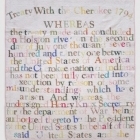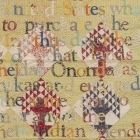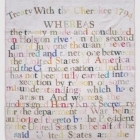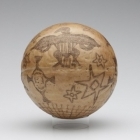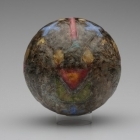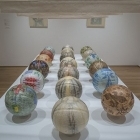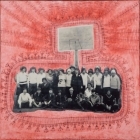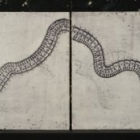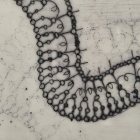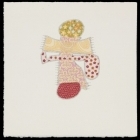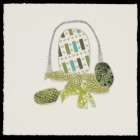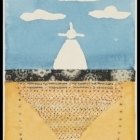Gina Adams
Biography
Gina Adam's cross-media studio work includes the reuse of antique quilts and broken treaties between the United States and Native American tribes, sculpture, ceramics, painting, printmaking and drawing. She is American descendant of both Indigenous (Ojibwe-not enrolled) and colonial immigrants of Irish and Lithuanian descent. In 2015 the noted international art critic Lucy Lippard wrote the introduction to her solo exhibition at the Nerman Museum of Contemporary Art, which launched her art career with the Broken Treaty Quilts Series. In 2017, Adams presented and exhibited at the AIW Conference at Goldsmiths College, University of London, England and was included in Monarchs: Brown and Native Contemporary Artists in the Path of the Butterfly, curated by Risa Puleo, which traveled to six museums including the Bemis Center of Contemporary Art. Adams has been selected for such prestigious awards and fellowships as the SARF Smithsonian Artist Research Fellowship, Dartmouth College Artist-in-Residence program (solo exhibit and catalog) and the Kohler Arts Industry/Residency. In 2019 Adams has solo exhibitions at the CU Art Museum, Boulder CO and Edgewood College, Madison, WI in addition to group exhibitions at numerous other museums.
Adams’ work is included in private and public collections including The Boston Museum of Fine Arts, Boston, MA; The Peabody Essex Museum, Salem, MA; The Portland Art Museum, Portland, ME; The Hood Museum, Hanover, NH; The Asheville Art Museum, Asheville, NC; University of Kansas, Lawrence, KS; Emprise Bank, Wichita, KS; Nerman Museum of Contemporary Art, Kansas City, MI; Spencer Museum of Art, Lawrence, KS; Great Plains Museum, Lincoln, NE; the Museum of Contemporary Native Arts, Santa Fe, NM and North American Native Museum, Zurich, Switzerland. In recent years Adams' work has been featured in publications including The New Yorker, Hyperallergic, The New York Times, Huffington Post, The Wall Street Journal and Art Newspaper among others.
Gina Adams spent her early youth in the San Francisco Bay, and her adolescent and early adult years in Maine. Her formal education includes a BFA from the Maine College of Art and MFA from the University of Kansas. She currently is the Assistant Dean of Foundations and Assistant Professor position at Emily Carr University of Art & Design in Vancouver, British Columbia.
___
I have chosen to use Calico Fabric as it was the first industrialized commodity that was made in the United States and then exported to Europe. The fabric was milled in the northeastern portion of the United States, while the production of cotton, and its connection to slavery were intrinsically tied together. I have chosen to place the broken treaty onto antique quilts that are roughly the same age, and appear worn and broken. In fact, they could have been made at the same time the treaties were drawn up and signed.
Quilting is thoroughly American; the quilt and quilting bees symbolize community and the promise to work together as a group to finish a major endeavor. While it is difficult to know for certain who made the original quilts in the project, there is reason to believe they'd been thrown out due to their worn appearance. Sewing together injustice with an object of comfort stirs deep emotion as the burden of the broken treaty is placed it on top of the hand quilted work that I believe symbolizes part of Manifest Destiny, and the wagon trains westward. The visual art exhibition is my form of storytelling. I am moved by a sense of discovery and connection, and much of it is deeply connected and rooted within place and land.
I choose to work in museum and library archives to make historical discoveries that can be reinterpreted into a visual language that has the ability to make sustainable social change. Once I have completed the research, then I decide the medium that is best suited to visually show the impact the history has had on our social political landscape. I ultimately feel responsible to be artistically clear so that the viewer leaves the exhibition feeling that they have learned something new and also possibly a detail or two about how they can add to the conversation so that we can all become allies in this work together.

